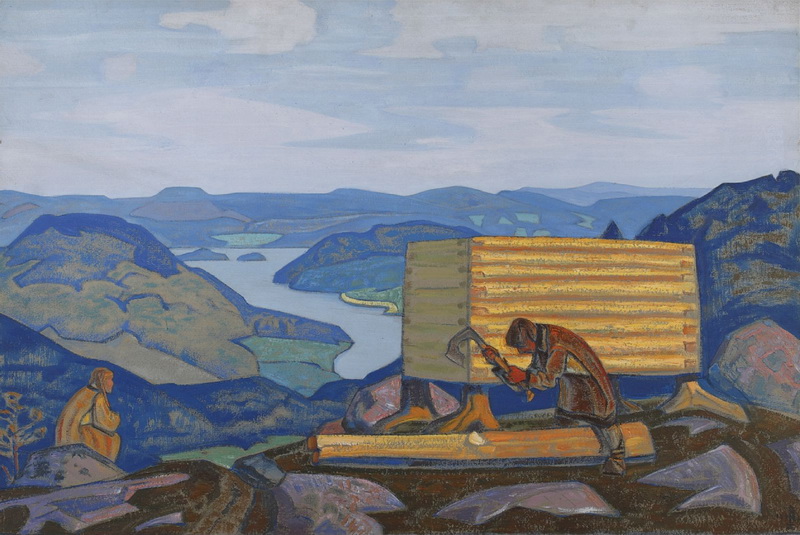 >>
>>
| Картины Н.К.Рериха |
<<  >> >>
| сменить фон |
Ссылка на изображение: http://gallery.facets.ru/pic.php?id=3390&size=3
| |
|
|
||||||||||
|
||||||||||
|
||||||||||
Надземное, 772 Урусвати знает, что ныне совершается трудное восхождение народов. Каждый поднимается по-своему: кто — войной, кто — бедствием, кто — трудом, кто — знанием, кто — подвигом, каждый несет свою карму. Она бывает легка, но бывает и очень тяжкая карма народная. Утверждайте, что в таком движении народов не может быть возврата к прошлому. Каждый осознавший непреложность эволюции, тем самым уже облегчает участь свою. Каждый, кто поймет закон труда во имя человечества, уже помогает себе в восхождении. Каждый, кто сумеет полюбить такие решающие пути народов, поможет себе. Так великая ответственность обращается в легкую ношу. Спросят: «Почему этот век называется Веком Матери Мира?» Истинно, так должен он именоваться. Женщина принесет великую помощь, не только внося просвещение, но и утверждая равновесие. Среди смятения магнит равновесия нарушается и нужна свободная воля, чтобы соединить распадающиеся части. Майтрейя — Сострадание нуждается в сотрудничестве. Кто жертвует собою в честь великого Века, тот пожнет обильную жатву. Мыслитель говорил: «Умейте трудиться для всего человечества». |
||||||||||
|
||||||||||
LOT 21 PROPERTY FROM A PRIVATE COLLECTION, MOSCOW NICHOLAS ROERICH 1874 - 1947 NEW HOUSE 550,000—650,000 USD MEASUREMENTS 17 3/4 by 27 1/2 in., 45 by 66 cm DESCRIPTION signed with artist's monogram and dated 1917 (lower right) tempera and pencil on paper mounted on board PROVENANCE Private Collection, Russia
LITERATURE AND REFERENCES F. Grant et al., Roerich, Himalaya, A Monograph, New York, 1926, p. 196, possibly (not illustrated) A.V. Yaremenko, Nikolai Konstantinovich Roerich: his life and creations during the past forty years, New York, 1931, p. 35 V.V. Sokolovsky, N.K. Roerich: life and oeuvre, Moscow, 1978, p. 276
CATALOGUE NOTE In 1916 Roerich moved with his family from St. Petersburg to the shore of Lake Ladoga in Sortavala, Finland, where he slowly convalesced from a life-threatening illness. New House is one of the most compelling works from Roerich's Finnish period, and dated 1917, it is one of several provocative images he executed during the year of the Revolution. The title and subject of New House seem to perfectly embody the spirit of a time when, after the destruction of World War I and the Revolution had overthrown the Russian Empire, the Russian people were attempting to rebuild their lives and their nation's infrastructure. While one figure chops wood and actively constructs the home, the other sits and looks wistfully across the Karelian landscape to the land from whence they came. Scholars tend to disagree about Roerich's attitude toward the Revolution: some believe he remained in Finland because he wished to escape the upheaval in Russia, while others argue that he embraced the new system despite his "...naively utopian [belief]... that the arts lay outside the political sphere" (Jaqueline Decter, Nicholas Roerich: The Life and Art of a Russian Master, p. 109). Regardless, the change of political power in his homeland made a significant impact on his life and also on his canvases from this period. Roerich last visited St. Petersburg in 1918, leaving with his wife Helena on one of the last trains to Sortavala before the Soviet border was closed. They later moved from Finland to England to the United States before embarking on their epic journey to the Far East. Ever nostalgic for his homeland, Roerich intended to return to Russia, and he finally applied for a Soviet visa at the end of World War II. He died before receiving word that his visa application had been denied. |
||||||||||

